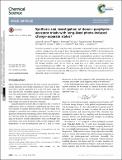Files in this item
Synthesis and investigation of donor-porphyrin-acceptor triads with long-lived photo-induced charge-separate states
Item metadata
| dc.contributor.author | Kelber, J.B. | |
| dc.contributor.author | Panjwani, N.A. | |
| dc.contributor.author | Wu, D. | |
| dc.contributor.author | Gómez-Bombarelli, R. | |
| dc.contributor.author | Lovett, Brendon William | |
| dc.contributor.author | Morton, J.J.L. | |
| dc.contributor.author | Anderson, H.L. | |
| dc.date.accessioned | 2015-11-06T13:10:03Z | |
| dc.date.available | 2015-11-06T13:10:03Z | |
| dc.date.issued | 2015-11-01 | |
| dc.identifier | 228921641 | |
| dc.identifier | 65e89844-2c91-4764-889e-7e04d4a0e8e1 | |
| dc.identifier | 84944049727 | |
| dc.identifier | 000362977000057 | |
| dc.identifier.citation | Kelber , J B , Panjwani , N A , Wu , D , Gómez-Bombarelli , R , Lovett , B W , Morton , J J L & Anderson , H L 2015 , ' Synthesis and investigation of donor-porphyrin-acceptor triads with long-lived photo-induced charge-separate states ' , Chemical Science , vol. 6 , no. 11 , pp. 6468-6481 . https://doi.org/10.1039/c5sc01830g | en |
| dc.identifier.issn | 2041-6520 | |
| dc.identifier.other | ORCID: /0000-0001-5142-9585/work/47136545 | |
| dc.identifier.uri | https://hdl.handle.net/10023/7752 | |
| dc.description | The authors thank the EPSRC for funding (grants EP/I035536/1 and EP/J015067/1). B. W. L. and R. G. B. acknowledge the DARPA QuBE program for financial support. | en |
| dc.description.abstract | Two donor-porphyrin-acceptor triads have been synthesized using a versatile Suzuki-coupling route. This synthetic strategy allows the powerful donor tetraalkylphenylenediamine (TAPD) to be introduced into tetraarylporphyrin-based triads without protection. The thermodynamics and kinetics of electron transfer in the new triads are compared with a previously reported octaalkyldiphenyl-porphyrin triad exhibiting a long-lived spin-polarized charge separate state (CSS), from theoretical and experimental perspectives, in both fluid solution and in a frozen solvent glass. We show that the less favorable oxidation potential of the tetraaryl-porphyrin core can be offset by using C, as a better electron-acceptor than triptycenenaphthoquinone (TNQ). The C-porphyrin-TAPD triad gives a spin-polarized charge-separated state that can be observed by EPR-spectroscopy, with a mean lifetime of 16 ms at 10 K, which is longer than in the previously reported TNQ-porphyrin-TAPD triad, following the predicted trend from calculated charge-recombination rates. | |
| dc.format.extent | 14 | |
| dc.format.extent | 1743700 | |
| dc.language.iso | eng | |
| dc.relation.ispartof | Chemical Science | en |
| dc.subject | QD Chemistry | en |
| dc.subject | NDAS | en |
| dc.subject.lcc | QD | en |
| dc.title | Synthesis and investigation of donor-porphyrin-acceptor triads with long-lived photo-induced charge-separate states | en |
| dc.type | Journal article | en |
| dc.contributor.sponsor | EPSRC | en |
| dc.contributor.institution | University of St Andrews. School of Physics and Astronomy | en |
| dc.contributor.institution | University of St Andrews. Condensed Matter Physics | en |
| dc.identifier.doi | 10.1039/c5sc01830g | |
| dc.description.status | Peer reviewed | en |
| dc.identifier.url | http://www.rsc.org/suppdata/c5/sc/c5sc01830g/c5sc01830g1.pdf | en |
| dc.identifier.grantnumber | EP/I035536/1 | en |
This item appears in the following Collection(s)
Items in the St Andrews Research Repository are protected by copyright, with all rights reserved, unless otherwise indicated.

